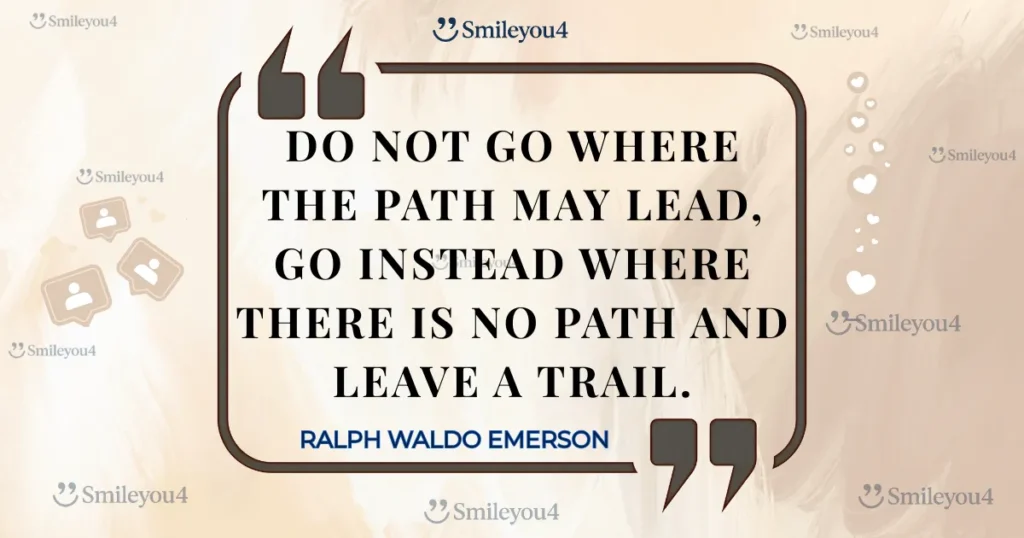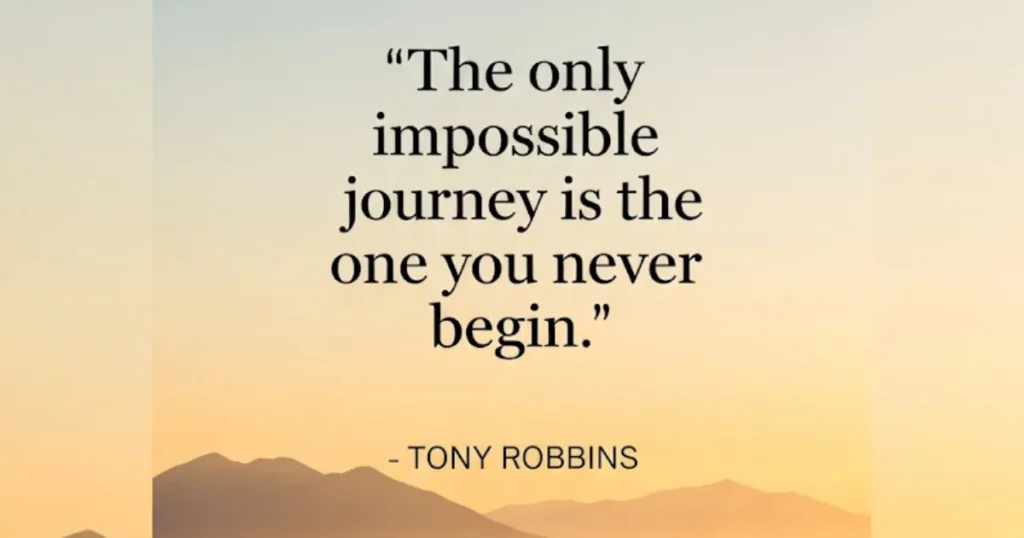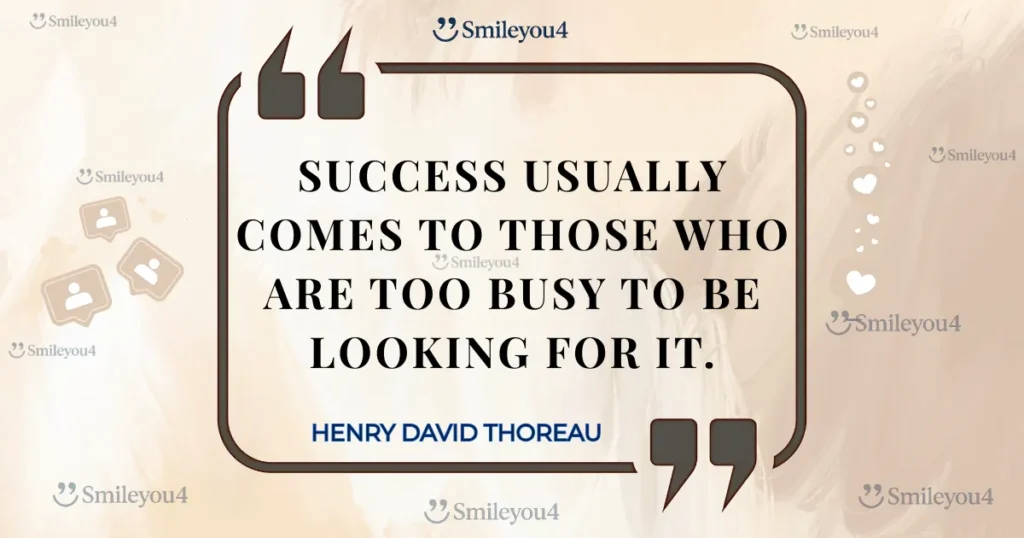What if the greatest gift you could give the world isn’t following someone else’s success formula, but creating your own? Ralph Waldo Emerson understood this revolutionary truth when he said, “Do not go where the path may lead, go instead where there is no path and leave a trail.” This Ralph Waldo Emerson quote isn’t just beautiful poetry—it’s a call to action that can transform how you approach every dream, career choice, and life decision.

Think about the people who’ve most influenced your life. Were they the ones who followed conventional wisdom, or were they the trailblazers who dared to do things differently? The entrepreneurs who started businesses everyone said would fail. The artists who created in styles no one understood. The leaders who championed causes others ignored. These people didn’t just succeed—they left a trail for others to follow.
Today, you’ll discover how to become one of those trailblazers. We’ll explore practical ways to trust your unique vision, overcome the fear of going it alone, and create a path that doesn’t just lead to your own success, but lights the way for countless others who will follow.
The Philosopher Who Dared to Think Differently
Ralph Waldo Emerson’s Revolutionary Mindset
When Ralph Waldo Emerson wrote about leaving trails instead of following paths, he spoke from personal experience as someone who consistently chose the unconventional route. As a 19th-century philosopher and writer, Emerson challenged traditional religious thinking, promoted individualism, and encouraged people to trust their inner wisdom over societal expectations.
Emerson didn’t just write about blazing trails—he lived it. He left his traditional career as a minister to pursue philosophy and writing. He championed transcendentalism when it was considered radical. He spoke out against slavery when it was socially risky. Every major decision in his life demonstrated his commitment to leaving a trail rather than following established paths.
This Ralph Waldo Emerson quote emerged from someone who understood that conformity might be comfortable, but it rarely leads to meaningful contribution. He discovered that your greatest gifts to the world often come from having the courage to be authentically, unapologetically yourself.
Why This Quote Speaks to Modern Pioneers
“Do not go where the path may lead, go instead where there is no path and leave a trail.” These words resonate powerfully today because they address our deepest desires for meaning and impact:
- “Do not go where the path may lead” challenges you to question conventional wisdom
- “Go instead where there is no path” encourages bold exploration into uncharted territory
- “Leave a trail” transforms personal courage into service to others
This philosophy works because it shifts your focus from safety to significance, from following to leading, from consuming to creating. When you commit to leaving a trail, you become an active participant in shaping the future rather than a passive follower of the past.
The Science Behind Trailblazing and Innovation
How Your Brain Responds to Creative Challenge
Modern neuroscience reveals fascinating insights about what happens when you choose to leave a trail instead of following established paths. Research shows that novel experiences and creative challenges literally reshape your brain, building new neural pathways that enhance problem-solving abilities and innovative thinking.
Mental benefits of trailblazing include:
- Increased neuroplasticity through exposure to new challenges and experiences
- Enhanced creative thinking as you develop unique solutions to unprecedented problems
- Greater resilience as you learn to navigate uncertainty and setbacks
- Improved confidence through proof that you can handle whatever comes your way
Psychological advantages:
- Higher life satisfaction from living according to your values rather than others’ expectations
- Increased sense of purpose as you create something meaningful and lasting
- Enhanced self-respect from choosing courage over comfort repeatedly
- Greater emotional intelligence through navigating complex, uncharted situations
This scientific backing proves that the Ralph Waldo Emerson quote isn’t just inspirational philosophy—it’s a practical strategy for optimal brain development and psychological well-being.
The Innovation Paradox
Studies show that while most people claim they want innovation and change, they often resist it when it actually appears. This “innovation paradox” explains why trailblazers face initial resistance even when their ideas eventually prove valuable. Understanding this pattern helps you persist through the inevitable challenges of leaving a trail.
Research reveals that truly innovative ideas typically follow a predictable pattern:
- Initial skepticism or rejection from established authorities
- Gradual acceptance as early adopters see the value
- Mainstream adoption once the benefits become undeniable
- Eventually becoming the new “conventional wisdom”
When you understand this cycle, you can leave a trail with greater confidence, knowing that resistance often indicates you’re onto something truly valuable.
Modern Trailblazers Who Changed the Game
Sara Blakely: From Door-to-Door Sales to Spanx Empire
Sara Blakely perfectly embodies the spirit of leaving a trail rather than following established business paths. When she couldn’t find the right undergarments to wear under white pants, she didn’t just complain—she invented a solution. With no business experience, fashion background, or startup capital, she created Spanx.
Her trailblazing approach included:
- Researching and developing her product without any industry experience
- Writing her own patent application because she couldn’t afford a lawyer
- Personally visiting department stores to pitch her unknown product
- Building a billion-dollar company by solving a problem others ignored
Blakely proves that when you leave a trail Ralph Waldo Emerson envisioned, you don’t need permission from experts or existing industry players. You just need courage to start and persistence to continue.
Elon Musk: Making the Impossible Inevitable
Elon Musk consistently chooses paths that don’t exist, from electric vehicles to space exploration to brain-computer interfaces. His approach to leaving a trail involves tackling problems that seem impossible and creating industries where none existed before.
His trailblazing methodology demonstrates:
- Identifying problems that everyone accepts as unsolvable
- Applying first principles thinking rather than following industry conventions
- Persisting through multiple failures and setbacks
- Building teams of people who share his vision for creating new possibilities
Musk shows that leaving a trail often means doing things others consider crazy until your success makes them seem obvious.
Malala Yousafzai: From Local Activist to Global Voice
Malala’s journey from a Pakistani schoolgirl to Nobel Prize winner exemplifies how leaving a trail can transform not just your own life, but the lives of millions. When faced with threats for advocating girls’ education, she could have stayed silent. Instead, she chose to speak louder.
Her path included:
- Speaking out for education rights despite personal danger
- Using her story to highlight global inequality and injustice
- Building a worldwide movement for educational access
- Proving that age and circumstances don’t limit your ability to create change
Malala demonstrates that the Ralph Waldo Emerson quote applies to social change as much as business innovation. When you leave a trail for justice and human rights, you can shift the entire world’s conversation.
Practical Steps to Start Leaving Your Trail
Begin with Honest Self-Assessment
Before you can leave a trail, you need clarity about what path you’re uniquely equipped to create. This requires deep self-reflection and honest assessment of your strengths, passions, and values.
Discover your trailblazing potential:
- List problems that consistently frustrate you—these often point toward your purpose
- Identify skills and talents that come naturally to you but might be rare in others
- Notice what activities make you lose track of time because you’re so engaged
- Ask yourself: “What would I do if I knew I couldn’t fail?”
Assess your current path:
- Evaluate whether your current direction aligns with your authentic values and interests
- Notice areas where you feel like you’re forcing yourself to fit into someone else’s mold
- Identify aspects of your life where you’re settling for “good enough” instead of pursuing “uniquely you”
- Consider what legacy you want to leave and whether your current path leads there
Start Small but Start Today
Leaving a trail doesn’t require dramatic life changes overnight. You can begin with small experiments that test your ideas and build your confidence in uncharted territory.
Daily trailblazing practices:
- Choose one small way to do something differently today than everyone else around you
- Practice expressing your authentic opinions instead of just agreeing with the crowd
- Look for opportunities to offer unique solutions to common problems
- Share one original idea or perspective on social media or in conversation
Weekly trail-building experiments:
- Try approaching a routine task in a completely new way
- Start a small project that excites you, even if you’re not sure where it will lead
- Connect with other people who are also blazing their own trails for mutual support
- Document your experiments and learnings to track your growing confidence
Build Your Trailblazer Toolkit
Successful trailblazers share certain characteristics that you can develop through intentional practice. When you leave a trail Ralph Waldo Emerson style, you need specific skills and mindsets.
Essential trailblazer qualities:
- Comfort with uncertainty and ambiguity
- Willingness to fail, learn, and adjust course
- Persistence in the face of criticism or skepticism
- Ability to communicate your vision clearly to others
Practical skill development:
- Practice decision-making with incomplete information
- Build a support network of other independent thinkers
- Develop thick skin for criticism while staying open to constructive feedback
- Learn to find resources and solutions creatively when conventional options don’t exist
Overcoming Common Obstacles to Trail Blazing
Moving Beyond Fear of Judgment
One of the biggest barriers to leaving a trail is fear of what others will think. This fear keeps countless people trapped in paths that don’t fit them, following routes they never chose.
Strategies for handling criticism:
- Remember that criticism often comes from people who gave up on their own dreams
- Focus on feedback from people whose opinions you actually respect and trust
- Use criticism as data about your impact—if you’re not getting some pushback, you might not be pushing boundaries enough
- Develop internal validation so your self-worth isn’t dependent on others’ approval
Building confidence in your unique path:
- Keep a record of times when your unconventional approach led to better results
- Study biographies of other trailblazers to see how they handled similar challenges
- Find a community of fellow independent thinkers who support each other’s journeys
- Practice self-compassion when experiments don’t work out as planned


